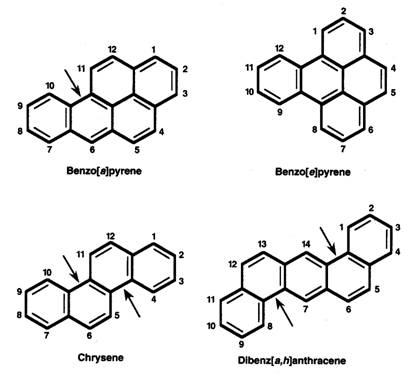How Do PAHs Induce Pathogenic Changes?
Upon completion of this section, you will be able to
- describe how PAHs are believed to induce pathogenic changes.
A key factor in PAH toxicity is the formation of reactive metabolites. Not all PAHs are of the same toxicity because of differences in structure that affect metabolism.
Another factor to consider is the biologic effective dose, or the amount of toxics that actually reaches the cells or target sites where interaction and adverse effects can occur.
CYP1A1, the primary cytochrome P-450 isoenzyme that biologically activates benzo (a) pyrene, may be induced by other substances [Kemena et al. 1988; Robinson et al. 1975].
The mechanism of PAH-induced carcinogenesis is believed to be via the binding of PAH metabolites to deoxyribonucleic acid (DNA).
Some parent PAHs are weak carcinogens that require metabolism to become more potent carcinogens. Diol epoxides “PAH intermediate metabolites” are mutagenic and affect normal cell replication when they react with DNA to form adducts. A theory to explain the variability in the potency of different diol epoxides, “the bay theory,” predicts that an epoxide will be highly reactive and mutagenic if it is in the “bay” region of the PAH molecule (Figure 1) [Jerina et al. 1976 and 1980; Weis 1998]. The bay region is the space between the aromatic rings of the PAH molecule.

Figure 1.
PAH-induced carcinogenesis can result when a PAH-DNA adduct forms at a site critical to the regulation of cell differentiation or growth. A mutation occurs during cell replication if the aberration remains unrepaired. Cells affected most significantly by acute PAH exposure appear to be those with rapid replicative turnover, such as those in bone marrow, skin, and lung tissue. Tissues with slower turnover rates, such as liver tissue, are less susceptible.
Benzo(a)pyrene diol epoxide adducts bind covalently to several guanine positions of the bronchial epithelial cell DNA p53 gene, where cancer mutations are known to occur from exposure to cigarette smoke. This is one possible genotoxic mechanism of cancer causation by tobacco [Denissenko 1996].
CYP1A1 inducible persons might be at greater risk for the effects of PAHs.
Persons with a high degree of CYP1A1 inducibility may be more susceptible to PAH health risks. Genetic variation in CYP1A1 inducibility has been implicated as a determining factor for susceptibility to lung and laryngeal cancer.
CYP1A1, the primary cytochrome P-450 isoenzyme that biologically activates benzo (a) pyrene, may be induced by other substances [Kemena et al. 1988; Robinson et al. 1975].
Glutathione transferase deficiencies may result in elevated cancer risk. Several studies have focused on breast cancer risk and metabolism of PAHs [Ambrosone et al. 1995; Calaf and Russo 1993; Davis et al. 1993; Hecht et al. 1994].
Several animal studies have implicated the ras oncogene in PAH tumor induction [Chakravarti et al. 1995; DiGiovanni et al. 1993; Ronai et al. 1994].
- The formation of reactive metabolites and the biologically effective dose are key to PAH toxicity.
- Diol epoxides—PAH intermediate metabolites—are mutagenic and affect normal cell replication when they react with DNA to form adducts.
- The location of epoxides in the bay region of a PAH predicts reactivity and mutagenicity.
- DNA adducts, as markers of exposure used in research, can be measured in various biologic media.
- The ability of CYP1A1 to biologically activate PAHs may be heritable and thus point to genetically susceptible populations at risk of PAH carcinogenesis.